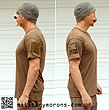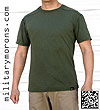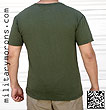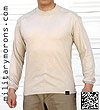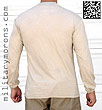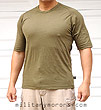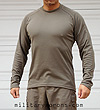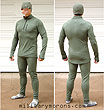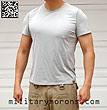Light Weight Base Layers Page 1,
2
This section features 'Next to skin' garments
As a sizing reference: I'm 5'7", 155 lbs (yeah, I'm a little guy), medium build (BDU top medium/regular, BDU pant medium/short), waist 32", chest 43". Keep this in mind when you read my comments with respect to sizing, so you have an idea of how the garments featured below will fit on you. ALL garments in these pages are size Medium, unless stated otherwise.
TO VIEW FULL SIZE IMAGES: USERNAME and PASSWORD are both "mm"
| 8/1/12 - The Operator's Shirt from 215Gear is designed as a light weight, feature-filled shirt for today's warriors. Made out of CoolMax® fabric, it offers great sweat-wicking properties, quick drying and comfort. The Operator's Shirt isn't just a cotton tee with velcro on the sleeves; it's a performance tee with a tactical touch, and made in the USA. It's currently available in the short sleeved version shown here, and a long sleeved version, and only comes in the coyote brown/dark earth shade pictured. It's a really nice colour, and a nice change from the lighter, more common tan shirts. It's made out of CoolMax fabric, but I don't know the exact fabric designation. CoolMax is owned by Invista, and they made a bunch of different fabrics under the CoolMax name, so even if you've had some CoolMax shirts before, there's no guarrantee that it's going to be the same fabric or even similar. Some CoolMax t-shirts I have are very soft, synthetic-feeling and smooth. The Operator's Shirt feels more 'natural' than synthetic, and has a more textured weave than some of the other synthetics. It actually has more of a merino wool feel than silky feel. To some, it may even feel a bit scratchy when new, but this disappears after the first few washes as the fabric softens up. The Operator's shirt is contructed using 'flat seam stitching and a tagless design' to 'eliminate the potential for "hot spots" from wear' (per the 215Gear website). I'd like point out that flat seam stitching is not the same as flatlock stitching, and this can be a bit confusing, as the term is used so much. When I read 'flat seam stitching', I was expecting the seam to be completely flat. Looking it up to educate myself, I found that the 215Gear website was indeed correct - the t-shirt is constructed with flat seam stitching with an overlock (serged) stitch, which is how most t-shirts are constructed. This is however different from a flatlock seam, which I originally thought was a flat seam. The flatlock seam joins the edges of fabric together without the seam allowance with layers folded to the underside. The flatlock seam has a flat profile whereas the flat seam (depending on the fabric) still has a raised ridge on the back side. Now, I've actually had regular t-shirts with flat seams feel more comfortable than some with flatlock seams which seems odd. This is because the thread used on the flatlock seams (often nylon) was more abrasive and scratchy than that used on some flat seams. So, besides the seam construction, the material and thread type is also a factor, and you can't just assume that a flatlock seam is automatically more comfortable than the standard flat seam. With the 215Gear Operator's shirt, I didn't find the flat seams to create any noticeable hot spots when wearing armour, so the flat seam construction is a non-issue. The 'tactical touch' is the addition of a 4" x 4" loop Velcro patch on each shoulder for IFF and unit patches. The 215Gear website states that the Operator's Shirt has a generous cut, but I found it to fit true-to-size. I'm a size medium (and gota medium shirt), and it was neither tight, nor baggy on me - pretty much a perfect fit. As you can see in the photos, there's really no excess room, so going down a size would have been too snug on me. I wore the Operator's Shirt in a handgun class in the summer heat, and found that it worked as well as other wicking t-shirts. It dried fast and didn't leave me feeling soggy like cotton.
|
CORDURA brand Baselayers by Tru-Spec
| 5/26/10 - More than a year ago, I wrote about the Tru-Spec Combat Shirt with its CORDURA® Brand baselayer™ 'no melt, no drip' torso. CORDURA now offers a line of base layer garments made out of this fabric for military and public safety professionals, manufactured by Tru-Spec/Atlanco. The garments are manufactured from a 60/40 cotton/nylon jersey knit that's more comfortable, protective and durable than 100% cotton. Materials - The 60/40 cotton nylon no melt, no drip CORDURA® Baselayer fabric is Invista/CORDURA's new next-to-skin fabric that claims exceptional moisture management, comfort and durability while offering no melt/no drip thermal properties. It's not advertised as fire-resistant nor flame retardant, but just that it will not melt or drip onto the skin like polyester when exposed to high temperatures. It will act like most other natural fibers like cotton or wool and provide limited insulation against flame/flash fires. From the Baselayer press release:
Six different garments are offered:
Shown below are the crew neck short sleeve shirts in Sand and Marine OD, and the mock neck long sleeve shirt in sand (size medium shown):
Here are the main features of the CORDURA® brand baselayers by Tru-Spec:
Observations and notes - As mentioned in the review of the Tru-Spec Combat shirt, the CORDURA® brand Baselayer fabric is very comfortable - it's smooth, very soft, and feels like cotton; only with more stretch. They have a more natural feel than the fully synthetic garments. The fit is good on me - not too tight nor baggy, as you can see in the photos. I wore the t-shirts jogging and also for daily use, and they feel like well worn (soft) cotton, but didn't get heavy and clammy when soaked with sweat. It dried faster than 100% cotton as well. Honestly, the difference in performance between most wicking garments I try is becoming hard to discern - they've all been pretty comfortable and performed well. The differences are more in how they feel - tight, loose, synthetic, natural etc, and it's mostly personal preference when it comes to those factors. One thing I did notice about the long-sleeve shirt is that the sleeves were a bit short. I don't have ape arms, and they were too short after washing to use the thumb loop. I contacted Tru-Spec about this and they informed me that this was being corrected. I also wore the same shirt for some days without washing, and found that it didn't start smelling like 100% cotton does, but didn't smell completely fresh either. That's about on par with what I found with other odor-inhibiting garments, like those with x-static etc. There will usually be a slight smell. The only stuff so far that I've found to have almost no odor after a few days' constant wear is merino wool. That being said, if you prefer a more 'natural' feel to your baselayers with 'no melt, no drip' being a requirement, the Cordura brand baselayers would be a good choice.
|
Rammite Australia Merino Short Sleeve T-shirt
| 12/21/06 - Hailing from down under is Rammite Australia's Merino Layering System, shown here with more of their military items available from MissionPac. Rammite is based in Perth Western Australia and their entire operation is run inside Australia from selection of the merino wool to the final making of the garment in Perth. Some of the advantages of wool are durability, insulation for both hot and cold climates, absorbance (wicking), flame resistance (natural fibers are recommended if exposure to flame is a risk), resilience, odour and static resistance. However, I'm very cautious when it comes to wool products, as I'm one of those individuals in the minority whose skin can get irritated even by the fine fibers of Merino wool, which I mentioned in my writeup on the Arc'teryx Emissary T-shirt. There's no such thing as an 'allergy' to wool, but rather a hyper-sensitivity of some individuals to the thickness of fibers. I asked Ric from Rammite to expound on the subject, and this is what he explained: "The main quality of Rammite
is our selection of the wool we uses in our products. Most wool used
in next to skin products cannot be worn by 5 to 10% of the population.
This is due to the itch factor which is proportional to the micron
count and the comfort factor of the wool being used. The thickness
of an individual wool fibre is measured in microns and 18.5 to 19.5
is the industry standard (our fibre is 18.5 microns). There should
be no problems with comfort regarding micron count as long as it is
below 19.5 microns. With that in mind, I asked Ric to send me only one of his items, not the entire line, just in case I had trouble with it. I selected the Light Weight Short Sleeved T-shirt, available in OD, charcoal and black. The shirt was designed to be worn under webbing/body armour, so the sleeve seams are kept off the webbing/body armour pressure points on top of the shoulder (see photos below). The shirt is longer than normal, which allows the tail to be below the webbing/trouser belt to stop it riding up when used in vehicle/mounted ops with body armour on. The sleeves are also longer than normal, ending just above the crook of the elbow. I like this feature, as there's less chance of it riding up under the arms when worn under another layer. All seams are flat, as well, for comfort under gear. Rammite has good relations with the Australian special forces, which has allowed them to improve their products from lessons learnt on the ground. Upon taking the shirt out of the package (it comes in its own little wool stuff sack) and putting it on, I did feel a very slight hint of prickle, which I don't feel when wearing cotton or synthetic-based garments, and only with wool. But it wasn't close to being bad enough to deter me, so I threw it on. I wore it for about 30 hours straight right out of the packaging the first time, and it felt fine after a short while and I forgot that it was wool. While it doesn't feel as 'silky' as most other synthetic fabrics, it didn't ever get uncomfortable, nor did I break out in any rash whatsoever. The real test was when I went running. Usually, sweat, combined with anything that's irritating can make me itch while cooling down, but the shirt felt just fine, much to my relief. It dried quickly, and never felt clammy. After the first wash, it softened up more. I was pleasantly surprised and impressed. The shirt performed very well throughout a range of temperatures during every day wear and exercise. Just a quick note on sizing - I usually wear a size medium top. Rammite sent me a size large which wasn't as loose as some other size large t-shirts I have to begin with, and it shrunk maybe about 5% from brand new when I machine washed and dried it the first time. It's a perfect fit now - not tight, just right (see photos). So, bear that in mind, that you might want to purchase the next size up for a relaxed fit.
|
| 1/24/08 - For over a decade, Beyond Clothing (formerly separate sites - Beyond Fleece and Beyond Tactical) has been a supplier of high-end custom made cold-weather fleece and soft shells for the outdoor/mountaineering community. With the launch of their new website in May 2007 and a move from Oregon to Seattle, WA, Scott Jones and the Beyond crew now offer an entire line of custom cold weather clothing, from base layers to insulated and wet weather garments. They also integrated their Tactical line into the Beyond Clothing site. Camber Layering System - In July 2007, Beyond was announced as the official manufacturer and supplier of the U.S. Special Operations Command (SOCOM) Custom PCU Cold Weather Layering System. This is based on the current PCU (Protective Combat Uniform) system, but integrated with Beyond's custom manufacturing and fit system, their garments and PCU-specific fabrics and materials. The Beyond PCU - Customization System (PCU-CS) includes 26 integrated garments and is officially available to those members of Special Operations Forces (SOF) who do not fit into the standard grades of the original PCU kit. For anyone who is not an SOF soldier, Beyond has developed the Camber Layering System, from which the garments here are featured. The Camber Layering System parallels and overlaps all the different levels in the PCU-CS. The PCU-CS served as the basis for the Camber, and the main difference between the two systems is that PCU-CS is restricted to govt-specified PCU-specific materials, whereas with the Camber system, Beyond is pretty much unrestricted in their fabric/material choices, being a commercial line. Custom Fit System - What sets Beyond apart is their Custom Fit system. All garments are made to order through their website. Each garment has different options like colours, fabrics and features. You supply your measurements and pick the features you want, and Beyond will build the garment for you. What you get is a perfectly fitting garment with the options of your choice from their available menu for each garment. It's important to provide accurate skin measurements and not to compensate for a snugger or baggier fit in your measurements. Your preference in fit can be specified and Beyond will adjust the fit of the garment accordingly. For example, if you want a more relaxed fit at the waist for those big dinners, provide your correct waist measurement then later specify you want a looser waist or an inch (or whatever) added, and they'll take care of it. It's not complicated, and Beyond's website walks you through the entire process with clear instructions. It's also helpful to get someone to help with some of the measurements. Why bother with a custom fit? Well, some people don't fit into most off-the-shelf garments perfectly; one or two dimensions might be off at times. I'm lucky to be an average, medium size, and most off-the shelf garments fit me just fine. However, I have a shorter torso and jackets will sometimes end up being too long. I also have shorter legs, and wear medium-short. More often than not, I'll have to get the legs shortened. With Beyond's Custom Fit, you'll get a garment that fits you perfectly without having to get it altered and the wasted time and hassle. If for some reason the garment still doesn't fit right, Beyond has a 100% Right-fit guarrantee and will take it back and remedy it provided it's returned within 14 days of receiving it. Base Line Long Sleeve top - The Beyond Base Line Long Sleeve is a wicking layer made from a medium thickness synthetic, Sorbtek (data sheet here). Desert Khaki is sheown here. Sorbtek is stretchy, very lightweight for its thickness, and very comfortable. It provides moisture management by wicking away moisture 4 times faster than channeled polyester fabrics. I really like the cut of this top. The back panel wraps under the armpits to form a guesseted underamr so that there isn't a seam directly at the armpit. Flat seams are used throughout. The sleeves are a bit long, but I assume that this is for layering and also to ensure there's enough so that they don't ride up your wrists when lifting your arms above your head. The cuffs can simply be rolled over once to shorten them. The bottom of the Base Line is cut longer in the rear to ensure it stays tucked in during activity. I was given a choice of logo or no logo on the left sleeve, and chose to have the same-colour logo as it looks nice. I wore this top both as a base layer under a jacket and by itself in cooler weather while jogging, and found it extremely comfortable for temperatures in the mid 60's and below. The Sorbtek really is a great feeling and looking fabric that doesn't snag. I found it to be also quite abrasion resistant. I wore it to the range on a wet winters day, which ended up being a bit warmer during the afternoon, and I took my jacket off, wearing only the Long Sleeve. We did some drills which required rapid transition to the prone position with the elbows on concrete. When I did that, I thought to myself "Damn, I'm going to shred the elbows of this top", but much to my surprise, I couldn't make out any sign of wear. . |
TAD Gear Merino Wool Garments (currently discontinued)
| 3/21/08 - Triple Aught Design's (TAD Gear) new 'Green Label" (natural fibers) Merino Wool Garments are part of their A.C.E. (A.ll C.limate E.lementals) layering system, which describes their highly versatile, component apparel system. Each piece of the ACE system represents a component in an overall total system that can be worn autonomously or as part of layering combination. The ACE System offers performance and functionality from base and mid layers to outerwear. Featured here are three items from the ACE system: the Regulator Base layers, Equilibrium Full Zip Sweater, and the Flux Pullover Hoodie. All are made from Merino Wool. New Zealand Extra Fine Merino Wool - TAD Gear has introduced more styles and garments this year in merino wool because of the many benefits of this natural material. Wool is naturally fire resistant, breathable, durable, used in both hot and cold climates, odour and static resistant, and will keep you warm even when wet. It will not melt or stick to when exposed to flame. The ACE system components are currently available in TAD's M.E. Green and D.F. (Dark Field) Grey (almost black). As I've mentioned in previous reviews of wool garments, I have very sensiitve skin and fall in the small percentage of people that can find even Merino wool scratchy. However, TAD's merino products have the least amount of itch (none to almost none) that I've experienced with any merino wool product. This is due to the fine micron thickness of the extra/super fine merino wool selected for these garments. With some other merino wool garments I've used, there'd usually be some hint of itch until my skin got used to it. Much less so with the the TAD wool garments. Regulator Base Layers - The Regulator Base Layers are made of the highest grade of super-fine merino wool for next-to-skin comfort, combined with 5.5% lycra for stretch. This is the softest merino wool used out of all TAD's wool garments, for a body-hugging but unrestriced fit for mobility. I'd liken the weight to most other silk weight base layers. The Regulator layers shown here are in M.E. Green, which is a very close match for the issue Nomex flight gloves, only a hint lighter. The weave is fine, and absolutely no hint of prickliness at all, which is unusual for a wool garment (for me). They could be made of synthetics, as far as my skin is concerned. Top - The Regulator Top has a zip mock neck using a covert YKK zipper, and has a 5.5" x 3.5" trapezoidal zippered chest pocket for small items. The collar is not tight around my neck when fully zipped up - there's still some breathing room. The bottom hem is cut slightly longer in the back for tucking in. As you can see from the photos below (size Medium shown), the fit is streamlined to hug the body without being too tight. The cuffs have thumbholes so the sleeves don't ride up when donning additional layers or lifting your arms above your head. You can choose not to use the thumbholes, and the cuffs will function just like normal ones. Bottom - The Regulator Bottom is a full length cut with fly opening, and diamond crotch. The non-binding elastic waist looks sturdy and is wide enough to be comfortable on the waist. I wore the bottom under a pair of Force 10 Cargo utility pants back in early February, on a cold and windy night in the Nevada desert. It really made a difference between freezing and feeling comfortable.
The Merino wool garments tend to be slightly heavier and more dense than their synthetic equivalents, like base layers or lightweight fleece. However, due the the breathability of the wool fibers themselves, you're less likely to get stuffy when you sweat than with a synthetic fleece top (synthetic fibers do not soak up moisture - they wick it away. Wool fibers actually absorb moisture). One potential disadvantage I see to wool is that it's heavier than synthetic garments when soaking wet and takes longer to dry. Again, this is because the wool fibers are hydrophilic and absorb moisture more readily than synthetic ones. Dunk a wool garment into water with a synthetic one, squeeze out the excess water and compare the weights and you'll see. With a thin base layer however, it's pretty much a non-issue. As most of us know, wool can shrink. You don't just
throw it in the hot/cold cycle with the rest of the clothes and
dry it on high. The tags recommend a cold gentle cycle when machine
washing, and laying them flat to dry. However, I'd found that
I can machine dry these wool garments on the air only or low heat
setting without them shrinking if I'm in a hurry and don't want
to lay them out. |
| 7/13/10 - Triple Aught Design's (TAD Gear) Tech T base layers are their newest addition to the TAD layering family, and a departure from their previous Regulator base layers featured previously. Instead of the merino wool used in the Regulator garments, the Tech T's are made from silky smooth Cocona® blended textiles which utilize activated carbon from coconut shells integrated into the textile fiber to provide quick dry time, odor adsoprtion, and UV protection. The Tech Ts are offered in a short sleeve version and a long sleeve version, and are designed as performance base layers for year-round use. Cocona® Textiles - Cocona, Inc. is a privately held Colorado company focused on developing innovative technologies from natural sources. The Cocona name was created to emphasize that the activated carbon in their fabrics comes from recycled coconut shells; a natural and renewable resource. In a (coco) nutshell, Cocona permanantely embeds activated coconut carbon into the polymers used to produce their yarns. The activated carbon provides odor absorption that is contained inside the fiber and will not wash or wear out, unlike topical treatments. According to the Cocona website's literature, the pores in the activated carbon help spread perspiration over a larger surface area which accelerates evaporation and results in the fabric drying quicker. The Tech T's are made of 100% polyester; 48% of which is Cocona polyester. The Ti (titanium) colour is shown here. The T's are also available in M.E. Green. The Ti fabric is titanium coloured on the outside and a darker shade (gunmetal) on the inside. The feel of the fabric is very similar that used on the PCU Level 1 base layers made by SEKRI. Very smooth with a good amount of stretch. Short Sleeve Tech T - The Short Sleeve Tech T is designed as an active wear, wicking short sleeve T. All seams are flat. The Tech T has sleeves that are shorter than a regular T. The idea behind this was to give the shirt an 'active fit'. The designers felt that due in part to its form fitting nature, longer sleeves might bind. Long Sleeve Tech T - The Long Sleeve T has a short collar with a #3 reverse front zip that is backed by a flap for comfort. The shirt features a single panel under the arms for improved mobility and double-layered elbows for added durability.
Observations/Notes - I found that the Tech Ts fit very much like the Regulator Merino wool garments - they have a snug, 'athletic' fit. Size medium is illustrated here, and you can see that the fit is very streamlined with the minimum of excess material on me. I'm pretty close to a 'medium' build without being too skinny nor stout. The long sleeves are snug on my arms, which aren't big to begin with, so folks with larger arms might want to go a size up if they'd rather not have a very tight fit. There are two things I felt which could be changed on these garments. The first was the length of the sleeves on the Short Sleeve Tech T. I understand why the designers made them short, but they were a bit too short on my and I didn't like the way they'd ride up under my arm pits after a while. The fabric is stretchy enough that I don't think longer sleeves would bind much. I'd have preferred longer sleeves. The other is the thread used for all the seams. They're all flat seams, for comfort, but I felt that a softer type of thread could be used. The thread felt a bit scratchy compared to the silky smoothness of the rest of the fabric. It didn't bother me on the Short Sleeve T, but did on the Long Sleeve T. The seams running down the inside of the arm near the crook of the elbow, and the side panels on the torso felt a bit scratchy. Note that I've mentioned in other reviews that I have particularly sensitive skin; so much so that many merino wool garments feel scratchy to me while more people aren't bothered at all by them. This might be the case with the Tech Ts. I used the long sleeve T for jogging in the evening, and when the weather got warmer, switched to the short sleeve T. I also use the long sleeve one as a baselayer for camping. It was actually pretty comfortable, and I didn't notice the seams quite as much in the sleeping bag as I was pretty exhausted. The Cocona fabric itself works well - it dries quickly when wet or soaked in perspiration, and I couldn't detect any odor after a few days of wear. The long sleeve T is warm for its weight in cool weather and the short T is comfortable in hot weather. For jogging, both performed well, and if not for the two points I brought up previously (short sleeves and seams), there'd have been nothing to gripe about. If you've thicker skin than I, the seams might not bother you one bit. By the way, if you get one and notice the Latin phrase on the back of the TAD tag, it means "fortune favours the bold."
|
ATTENTION! PLEASE DO NOT LINK DIRECTLY TO MY IMAGES
-
IT RESULTS IN MY BANDWIDTH ALLOCATIONS BEING EXCEEDED,
AND MY PAGES GO DOWN. THANKS!
/ . PLEASE
OBSERVE AND RESPECT OUR COPYRIGHT! . /
©opyright by MilitaryMorons.com. All Rights Reserved. Reproduction, Duplication,
Distribution Strictly Prohibited.
Unless mentioned otherwise, content and images are the
property of militarymorons.com and are not in the public domain.
They are not to be used without
permission. Please Contact
me for permission to use any images or content herein.

